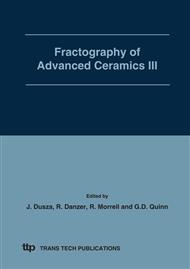[1]
F.W. Preston: J. Soc. of Glass Tech. Vol. 10 (1926), p.234.
Google Scholar
[2]
E.B. Shand: J. Am. Ceram. Soc. Vol. 42 (10) (1959), p.474.
Google Scholar
[3]
H. Wallner: Z. Phys. Vol. 114 (1939), p.368.
Google Scholar
[4]
Ch. De Freminville: Rev. Met, Vol. 11 (1914), p.971.
Google Scholar
[5]
R.W. Rice: Ceramic fracture features, Observations, Mechanisms and Uses, in Fractography of Ceramic and Metal Failures, edited by J. J. Mecholsky, Jr. and S. R. Powell, Jr., ASTM STP 827, Philadelphia PA (1984), pp.5-102.
DOI: 10.1520/stp37106s
Google Scholar
[6]
S.W. Freiman, J.J. Mecholsky, Jr. and P.F. Becher: Fractography: A Quantitative Measure of the Fracture Process in Ceramic Trans. 17, Am. Ceram. Soc., (1991), pp.55-78.
Google Scholar
[7]
J.C. Russ: Fractal Surfaces. Plenum Press, NY (1996).
Google Scholar
[8]
B.B. Mandelbrot, D.E. Passoja and J. Paullay: Nature Vol. 308 (1984), p. 721ff.
Google Scholar
[9]
A. Della Bona, T.J. Hill and J.J. Mecholsky Jr.: J. Mater. Sci. Vol. 36 (2001), p.2645.
Google Scholar
[10]
T. J. Hill, A. Della Bona and J. J. Mecholsky, Jr.: J. Mater. Sci. Vol. 36 (2001), p.2651.
Google Scholar
[11]
J.J. Mecholsky, Jr., T.J. Mackin and D.E. Passoja: Self-similar Crack propagation in Brittle Materials, Adv. In Ceramics 22: Fractography of Ceramics and Glasses, edited by Varner and Frechette, Am. Ceram. Soc. (1988).
Google Scholar
[12]
Y. Fahmy, J.C. Russ and C.C. Koch: J. Mater. Sci. Vol. 6 (1991), p.1856.
Google Scholar
[13]
J.J. Mecholsky, D.E. Passoja and K.S. Feinberg-Ringel: J. Am. Ceram. Soc. Vol. 72.
Google Scholar
[1]
(1989), p.60.
Google Scholar
[14]
P.N. Randall: Plain Strain Crack Toughness Testing of High Strength Metallic Materials in ASTM STP 410 (1988), p.88.
Google Scholar
[15]
J.J. Mecholsky, Jr. and S.W. Freiman: J. Am. Ceram. Soc. Vol. 74.
Google Scholar
[12]
(1991), p.3136.
Google Scholar
[16]
Y.L. Tsai, T. P Swiler, J. H Simmons and J.J. Mecholsky, Jr., in: Computational Modelling of Materials and Processing, edited by J. H. Simmons et al., Ceram. Trans. Vol. 69 (1997), p.217.
Google Scholar
[17]
J.K. West and L. L. Hench: Phil. Mag. A Vol. 77(1) (1998), p.85.
Google Scholar
[18]
J.K. West, J.J. Mecholsky, Jr. and L.L. Hench: J. Non-Cryst. Solids Vol. 260 (1999), p.99.
Google Scholar
[19]
G.W. Quinn, J. Quinn, J.J. Mecholsky, Jr. and G.D. Quinn, in: Ceramic Engineering and Science Proceedings. Vol. 26 no. 2, (2005), p.77.
Google Scholar
[20]
J.J. Mecholsky, Jr.: Mater. Lett. Vol. 60 (2006), p.2485.
Google Scholar
[21]
J. Quinn, G. Quinn, J. Kelly and S. Scherrer: Dent. Mater. Vol. 21 (10) (2005), p.920.
Google Scholar
[22]
B. Taskonak, J. Yan, J. J. Mecholsky, Jr., A. Sertgöz and A. Koçak: Dent. Mater. Vol. 24 (8) (2008), p.1077.
Google Scholar
[23]
S.S. Scherrer, J.B. Quinn, G.D. Quinn et al.: Int. J. Prosthodont. Vol. 19 (2006), p.185.
Google Scholar
[24]
Y. Thompson, K.J. Anusavice, A. Naman and H.F. Morris: J. Dental Res. Vol 73 (1994), p.1824.
Google Scholar
[25]
J.Y. Thompson, K.J. Anusavice, B. Balasunramaniam and J. J. Mecholsky, Jr.: J. Am. Ceram. Soc. Vol. 78 (11) (1995), p.3045.
Google Scholar
[26]
T. J. Hill, J. J. Mecholsky, Jr. and K. J. Anusavice: J. Am. Ceram. Soc. Vol. 83 (3) (2000), p.545.
Google Scholar
[27]
K.T. Faber and A.G. Evans: Acta Metal. Vol. 31, no. 4 (1983), p.577.
Google Scholar
[28]
I. Hucklenbroich, G. Stein, H. Chin, W. Trojahn and E. Streit: Mater. Sci. Forum Vol. 318 (1999), p.161.
Google Scholar
[29]
Z. Chen, J. Cuneo, J. J. Mecholsky, Jr. and S. F. Hu: Wear Vol. 198 (1996), p.197.
Google Scholar
[30]
W.W. Chen, A. M. Rajendram, B. Song and X. Nie: J. Am. Ceram. Soc. Vol. 90 (4) (2007), p.1005.
Google Scholar
[31]
J.E. Kooi, R. Tandon, S.J. Glass and J.J. Mecholsky, Jr.: J. Mater. Res., Vol. 23, No. 1, (2008), p.214.
Google Scholar
[32]
J.J. Mecholsky, Jr., R. Linhart, B.D. Kwitkin and R. Rice: J. Mater. Res. Vol. 13 (1998), p.3153.
Google Scholar


